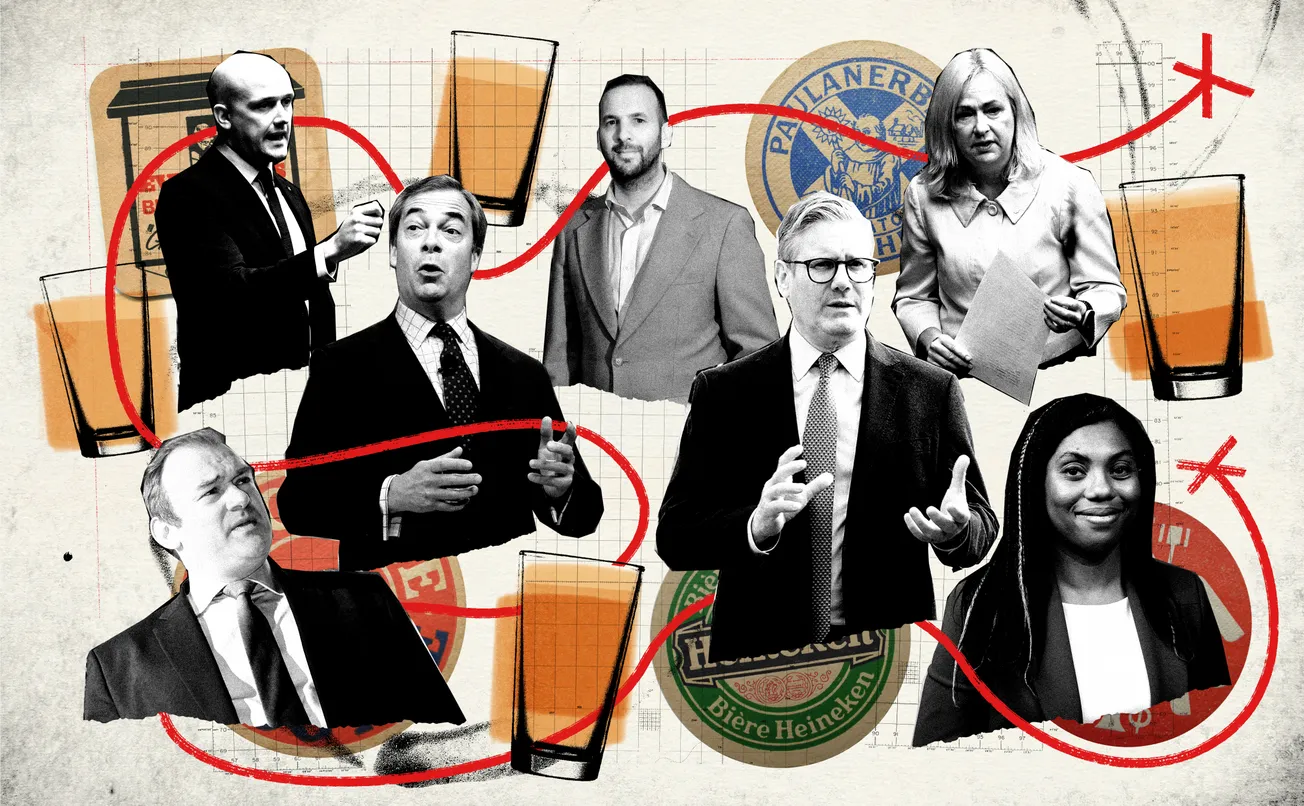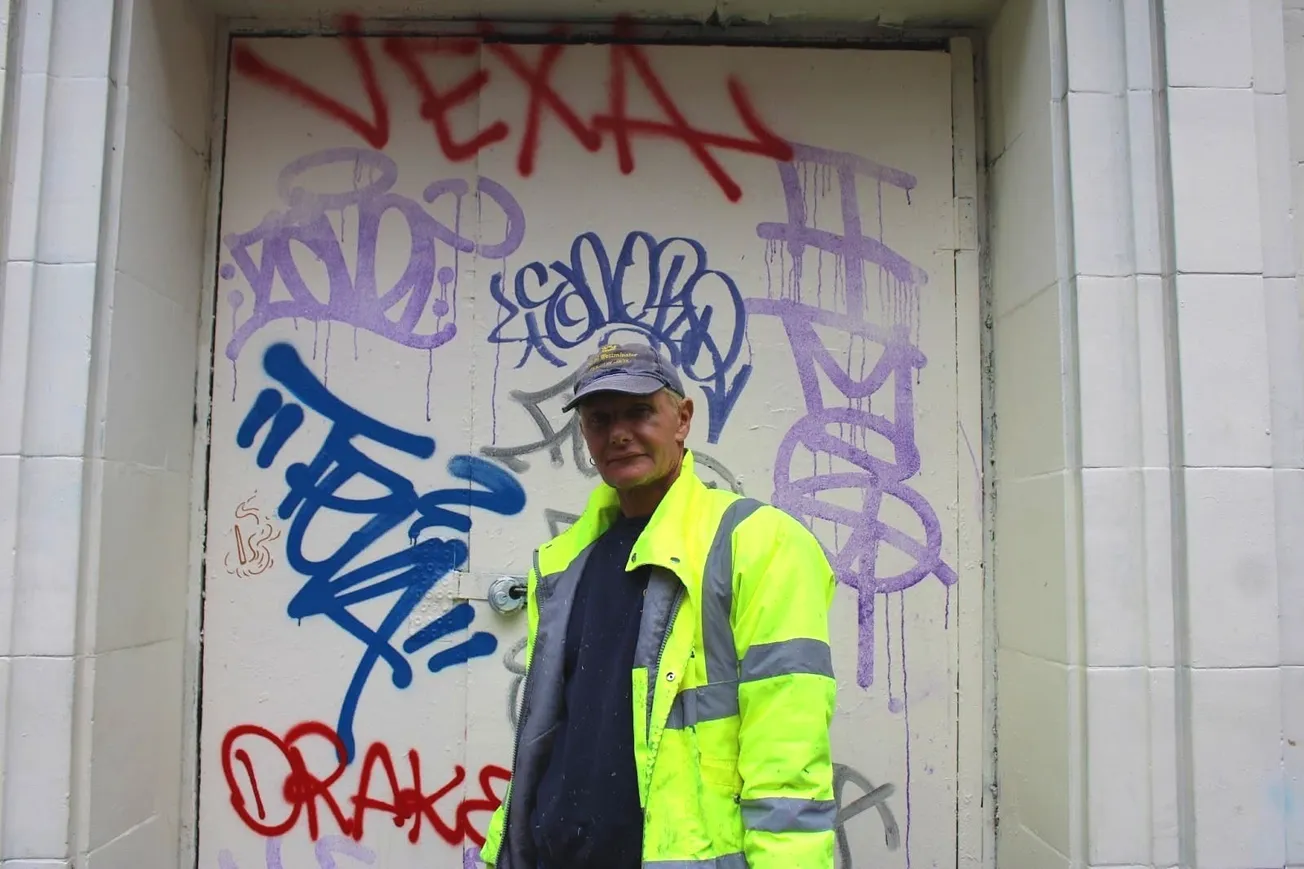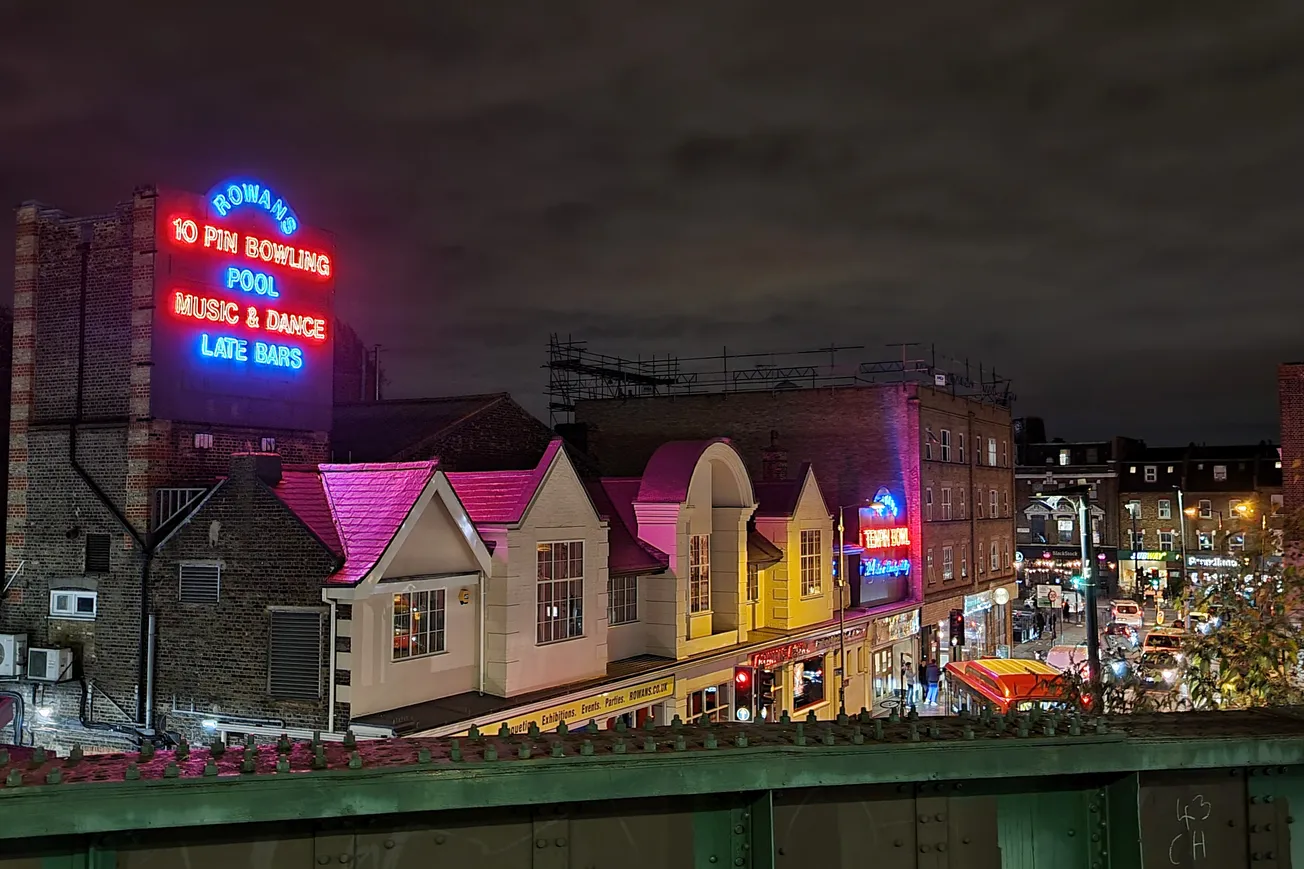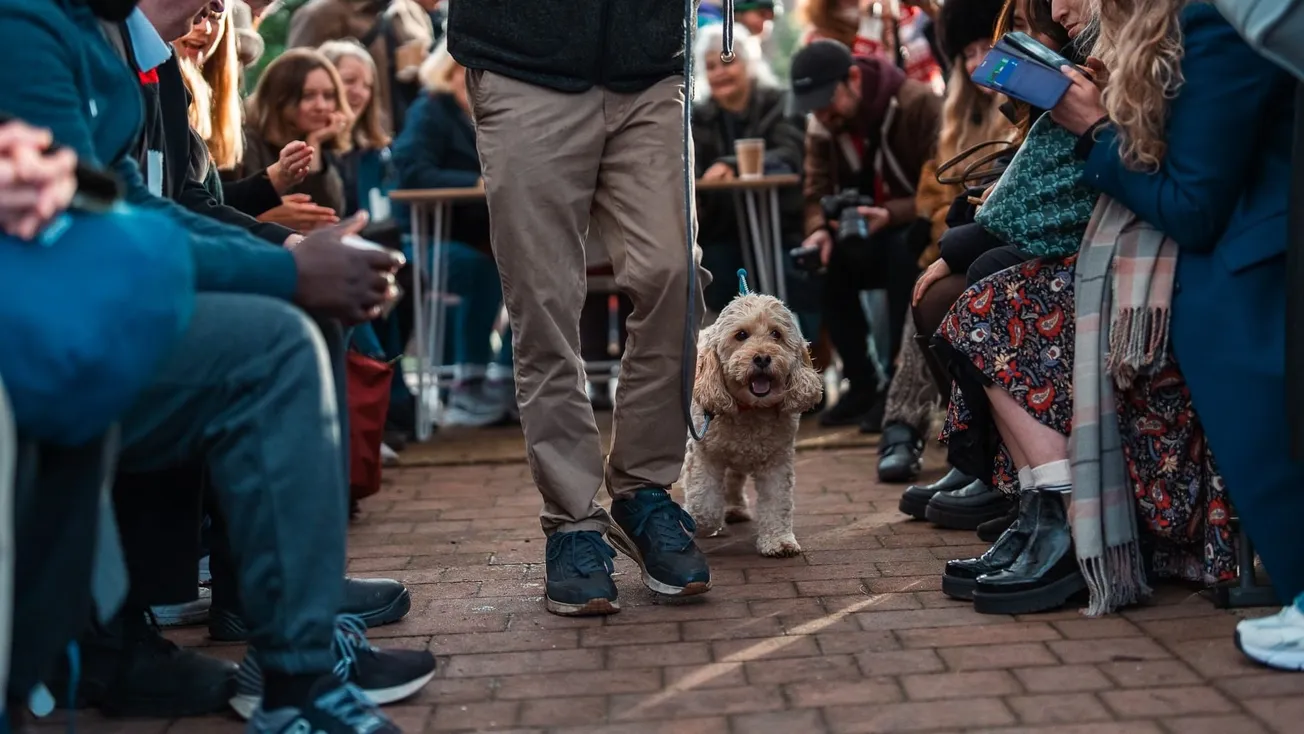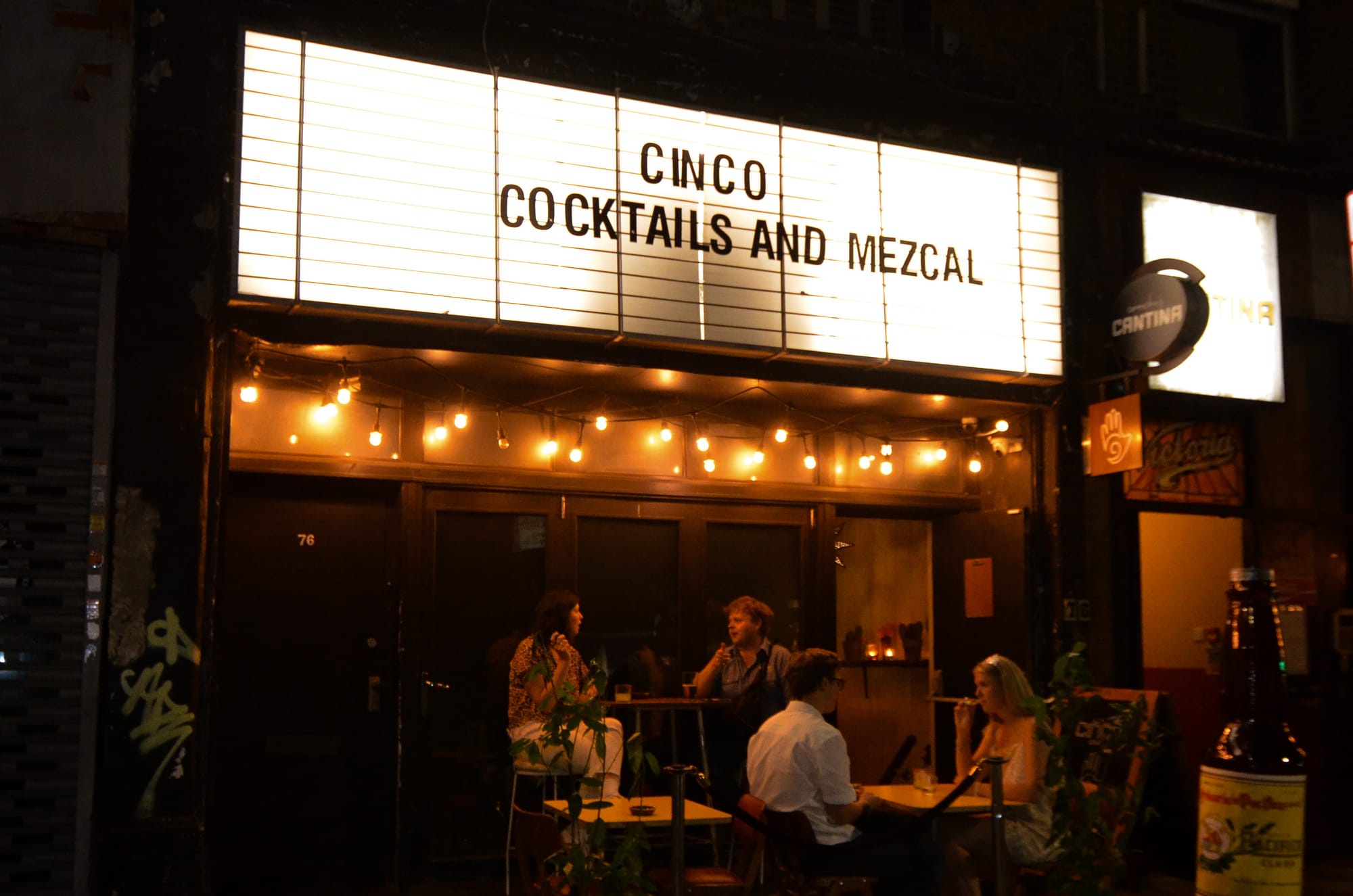Despite multiple obituaries claiming the contrary, Dalston’s nightlife has never been dead. Admittedly though, it might have entered an induced coma in the late 2010s, exacerbated by the subsequent pandemic years. The venues which established ‘The Strip’ — the long thoroughfare encompassing the upper end of Kingsland Road and bleeding into Stoke Newington High Street — as a party hotspot have mostly disappeared: Visions, Efes, Birthdays, Dance Tunnel, The Alibi, all lost to the sands of time. Previously a failsafe bet for the kind of low-effort, high-reward night out that didn’t require booking on Resident Advisor six months in advance, trekking to a warehouse in Zone 4 or taking out a pay-day loan, for a while Dalston was well… quiet.
Over the last couple of years, something of a resuscitation is afoot however, spearheaded by a collection of Latin-American bars and restaurants, which have cohered into a single, recognisable cluster, sometimes dubbed the ‘Mezcal Mile’. Corrochio’s, Cinco, Latino Hits, Viva, Doña, and Escudo de Cuba each offer something different — from the high-end to the cheapest and most cheerful of party spots — but together they have restored to Dalston its status as one of the best places in London to turn up, wander around and see what happens. My exposure to these venues has mostly been limited to walking past them on the way home from work; their bright-eyed patrons provoked a ghost-at-the-feast yearning – maybe I too would one day get to laugh uproariously with friends over mezcal and guacamole. Tired of missing out, last Friday I went down to the Latin strip to find out why it has exploded in popularity. Is a bonafide new scene on the ascent or is it just the two-for-one cocktails?
My first stop was situated at the Stoke Newington Road end, heading down narrow wooden stairs to Cantina and CINCO, two interconnecting basement bars. They’re owned by Corrochio’s, a Mexican restaurant next door. Cantina is lively and loud, with a DJ playing Latin music (occasionally interspersed with Western RnB classics), while CINCO — which opened earlier this year — is a sultry, candle-lit cocktail bar, the kind of place where people lean close and talk in low voices.
Behind both are married couple Daniel Corrochio, a chef who grew up in Gaudalahara, and his wife Amy McQuarrie, who manages the three locations. CINCO in particular is a premium operation; there’s a focus on proper agave and authentic Mexican tequilas, and the walls are adorned with trinkets brought back from Mexico by the pair. Eduardo, the head bartender, kindly rebuffed my efforts to speak to him in terrible Spanish and made me a mezcalita (‘El Rey’), which tastes incredible. I manage to grab McQuarrie for a quick chat; she starts by telling me that the strip is “100%” seeing a revitalisation. She blames gentrification between 2010 and 2015 for a closure of some of the most iconic late night Dalston spots — “licences became restricted or revoked [...] one venue would shut down and it was difficult for new venues to [replace] them”.
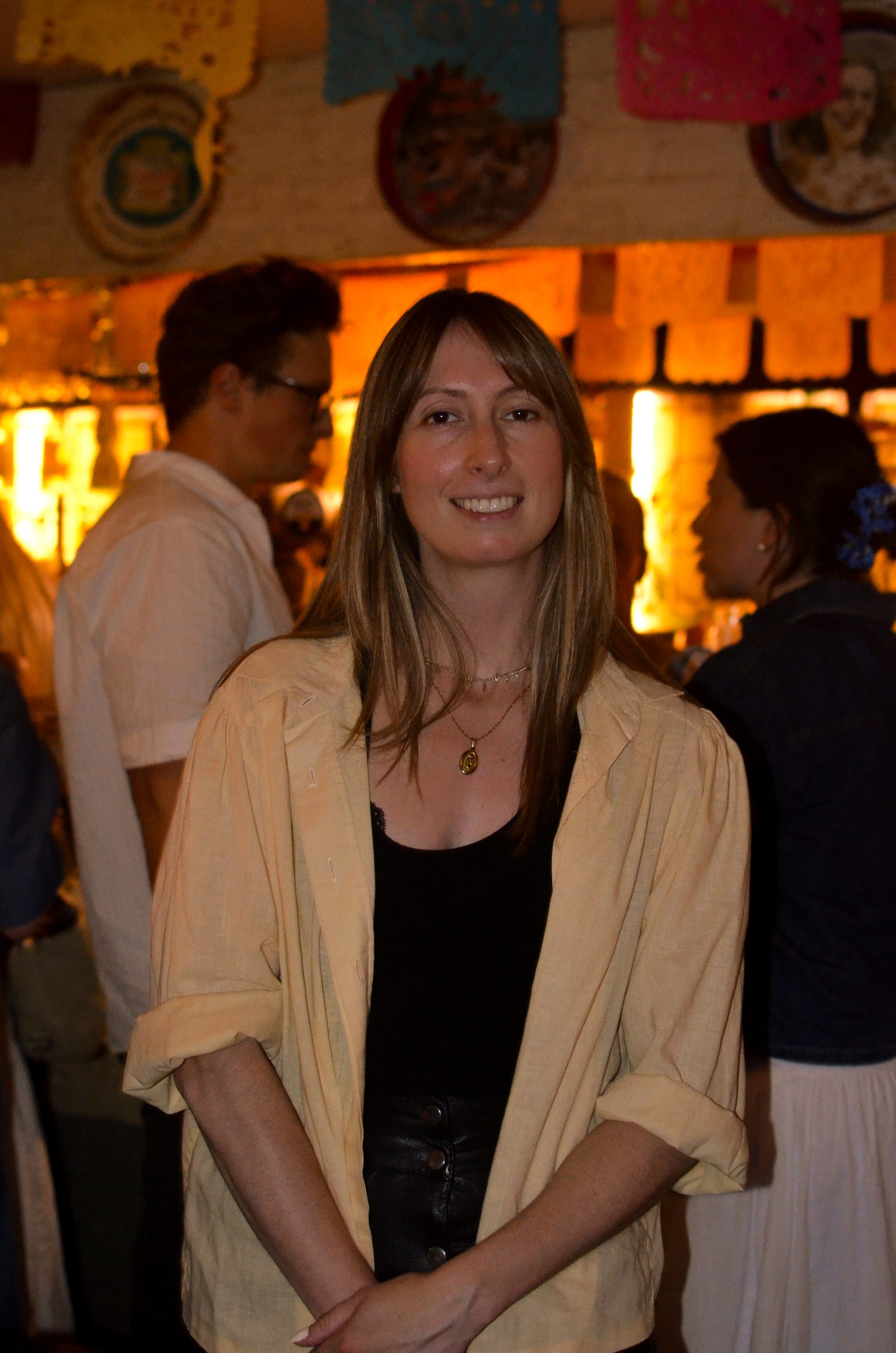
Perhaps Hackney council is more lenient now, but McQuarrie points out the Latin bars here aren’t wholly new — they’re just rising in profile. She notes the presence of Sin Gusano in Haggerston in 2018, and Escudo de Cuba just a few doors down, which has been a staple since 2012.
Tastes are shifting too, McQuarrie thinks. “Now people know that there are food and drink offerings outside of burritos, frozen margaritas and crap agave spirits, the appetite for the real deal is growing,” she tells me.
For a few minutes after leaving the Corricho’s complex, I contemplate buying this opinion wholesale until I arrived at the raucous Escudo de Cuba. Here, harried-looking waiters weaving trays of espresso martinis through clumps of vaping twenty-somethings. I’m not sure how many of them are here for an ‘authentic agave experience’. With its wooden flooring and hanging chandeliers, it at first feels both exotic and strangely cosy, like the Havana equivalent of an ‘old man pub’, somewhere you might have an unforgettable evening shooting the breeze and playing a little darts with Fidel Castro. But then Eduardo Ponce Soliz, one of the site managers, takes me downstairs to basement bar Tipsy, just in time to catch Sophie Ellis Baxter’s ‘Murder on the Dance Floor’ segueing into ‘Pink Pony Club’ by Chappell Roan — not the hip-swaying Latin vibes I was expecting.
The venue is primarily the venture of local hospitality businessmen, Marcos Chacon Arcentales. Under the umbrella of Escudo Limited, he owns Escudo de Cuba, Tipsy and Latino Hits down the street, as well as Jazzy Pizza just down the road. Tipsy melds Anglophone music with a Latin American aesthetic, for a crowd that wants to hear ABBA and drink £9 spicy margaritas.
“We used to do the same music as Latino Hits, but then people like a mixture of music — we’re trying to show them that they can choose where they want to go,” explains Eduardo, who grew up in Ecuador and has worked for the company for nine years.
Escudo de Cuba led the Latin charge, opening 13 years ago; Latino Hits followed a decade later. Interestingly, as its popularity — along with that of the ‘Mezcal Mile’ has grown, the clientele has notably shifted to include more of the Latin American diaspora in recent years, not less, says Eduardo.
In the bouncing Escudo de Cuba smoking area, I get chatting to Molly and Kaviya, who are hitting the strip before heading to a rave. “I think [these bars are so popular] because Dalston historically has a huge immigrant population, and even though it’s being gentrified, that presence is still strong,” says Kaviya, a student from India. For Molly, part of the appeal is a perceived authenticity, even while she’s sceptical that such a concept really exists. “People like going somewhere that isn’t a chain – it doesn’t just feel like being at All Bar One. There’s something attractive about the fact the [Latin] strip hasn’t been gentrified, which is maybe ironic to say as someone who would be gentrifying it,” she contemplates.
In London, it can seem that anything good exists on borrowed time; a buzzy area often becomes a victim of its own success, attracting developers like hawks. But for now, Dalston’s Latin strip doesn’t seem to be at risk of this fate, which has endangered Latin community spots in Seven Sisters and Elephant and Castle,
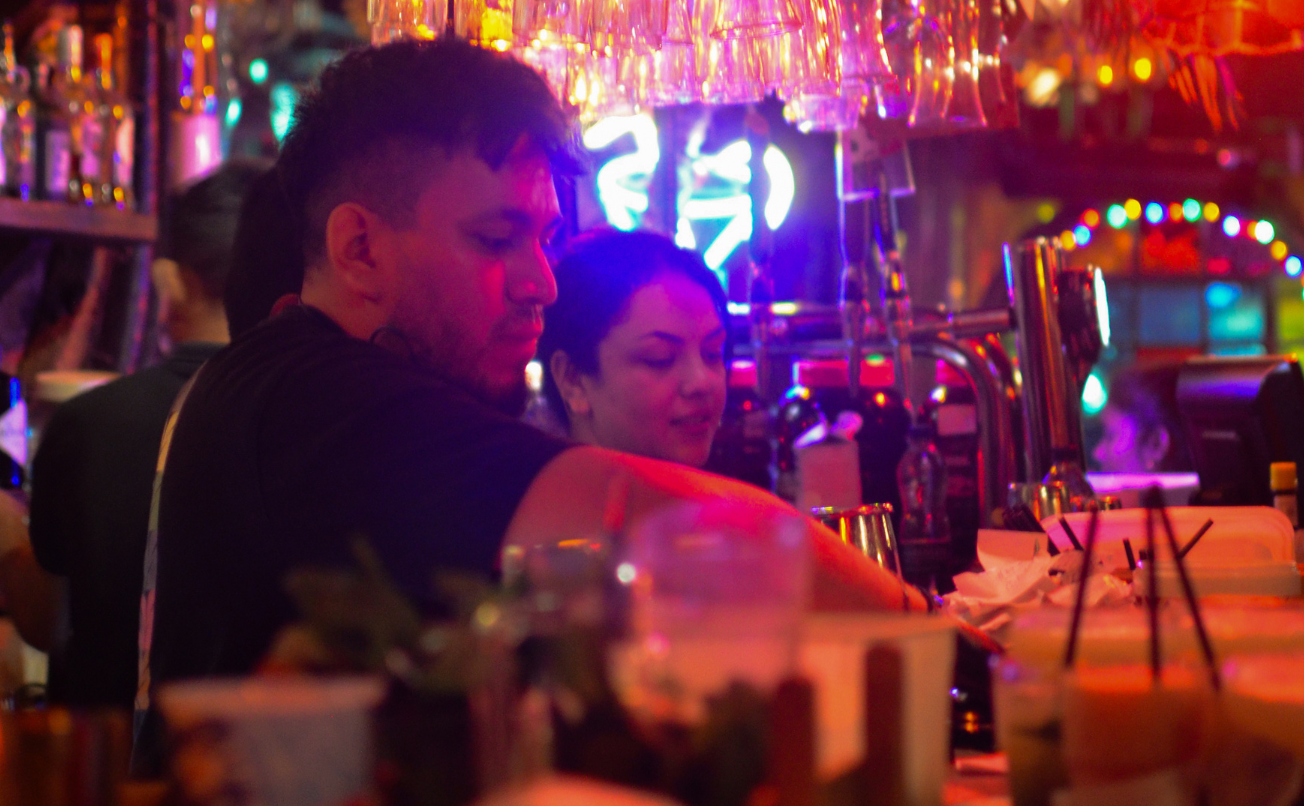
At Viva, another Kingsland Road mainstay launched in 2012, manager Will, tells me the biggest problem facing the strip is the rising costs of running a venue. “I don't think gentrification will affect it — Dalston is already half-gentrified anyway,” he says. “What’s making things harder is the economy. Everything is much more expensive. We are trying to keep our prices as low as possible, but we spend a lot of money on our ingredients.” It’s simply not financially viable for the bar to offer the kind of deals so beloved at Latino Hits.
Albie, a longtime local I corral on the pavement, feels the Latin bars have given Dalston a shot in the arm. “I’ve lived on Kingsland road for six years and there have been a lot of small plates moments, but this is what it actually needed,” he says. “It's cute, sexy, fun vibes, and there’s two-for-one cocktails at all hours of the day.” Albie is neither the first nor last person to wax lyrical about the cheap cocktails — in today’s London, the prices on offer in the likes of Tipsy and Latino Hits feel like a gift so miraculous they might have been bestowed by Our Lady of Guadalepe herself.
“These bars have definitely had the impact of bringing Dalston back to life,” agrees DJ Falcon, real name Dylan Bedoya, a DJ and producer who regularly plays Latino Hits. He’s just dropped a song from Puerto Rican superstar Bad Bunny’s new album when I arrive downstairs: the room is packed with a diverse crowd and some of the non-Spanish speaking contingent are making a respectable stab at shouting random bursts of the lyrics. Bodero is a very affable young guy, endearingly passionate about the music he plays. Born and raised in Hackney, he tells me that there wasn’t a big Latino community in the borough while he was growing up, at least not compared to Tottenham or Elephant and Castle, but he has noticed this changing in recent years. “Now there’s more bars opening up and it’s bringing more Latino people to the area. I think it could be a way of building the community,” he says.
Bedoya’s set is fully Latin, encompassing salsa, merengue, bachata, reggaeton, cumbia, and, as he put it, “a bit of old school music that grown-ups like to listen to to give them nostalgia of when they were back home in their countries.” Spanish-language music is experiencing a boom period, driven by rising popularity in the Anglophone world. A new wave of artists who, unlike most of the Latin superstars who preceded them, have achieved crossover success without releasing music in English. Bedoya has noticed the impact. “When I play Bad Bunny, [English] people actually sing along, and a lot of people have come back to the place because I play him or because they want to hear that kind of music”.
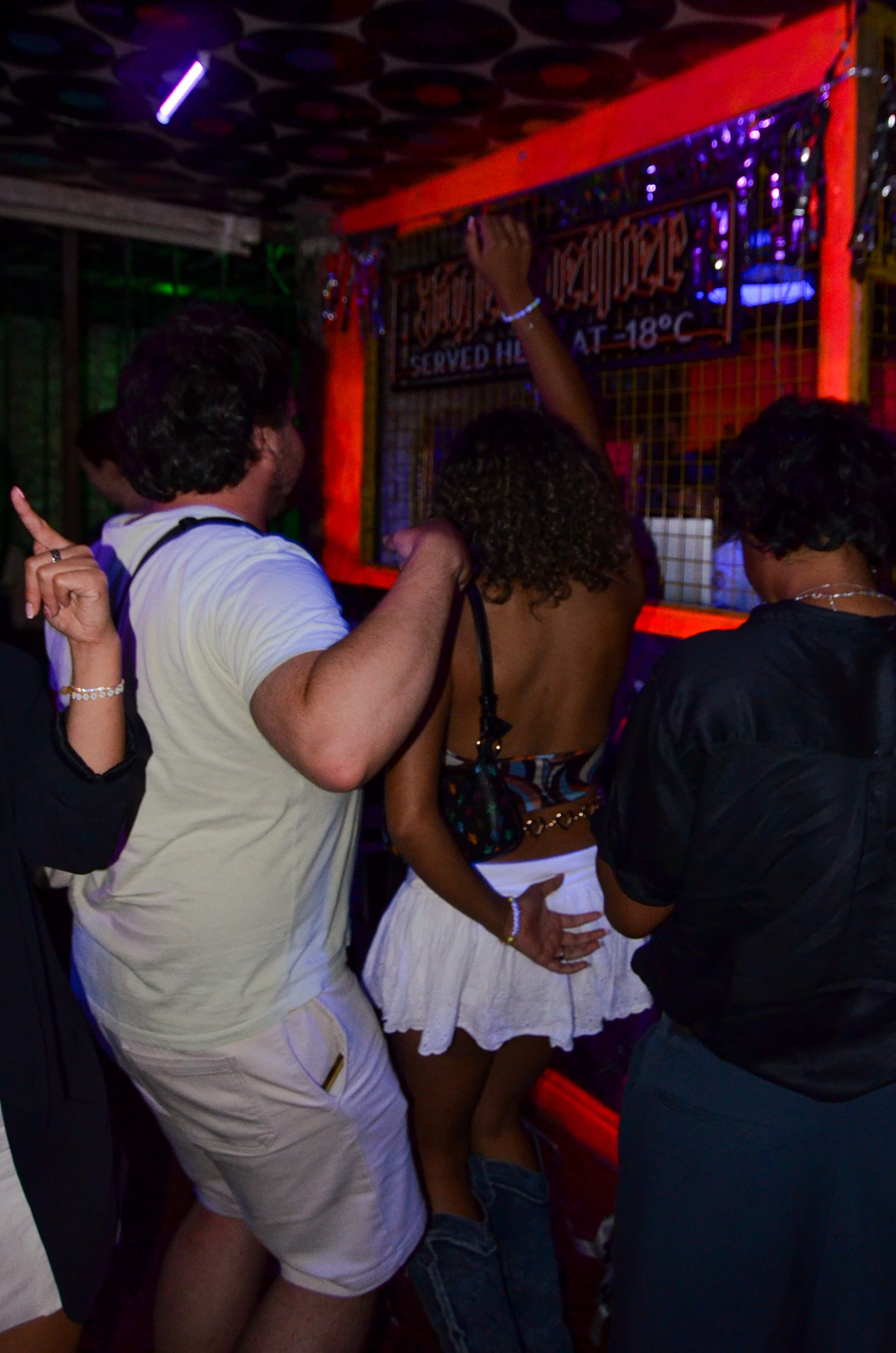
While mostly international, the music at Latino Hits also reflects a steadily growing Latin-American music scene in London. A number of artists, many of whom were born in the city, are blending Latin influences with contemporary British sounds. “I want that community to grow – there’s a lot of great potential here in the UK and the Latin scene is huge, but unfortunately it doesn’t always get the recognition it deserves,” says Bedoya. One of the several London-based artists he plays at Latino Hits is Mela B, his sister and a long-time collaborator; she writes her own music and Bedoya records, mixes and produces it in his studio bedroom. What becomes clear is that the Latin strip isn’t just a spot for cheap cocktails and Insta-friendly decor, but a showcase for local talent and a genuine scene.
Bedoya is hopeful that the popularity of these bars will draw more attention to London’s Latin-American population, one of the fastest growing migrant communities in London and estimated to be the eighth largest, yet one which remains, he says, sorely underserved. There is still no census category for Latin Americans, and most existing data about the size of the population is based on country-of-origin. This excludes British people of Latin American descent and those born elsewhere in Europe.
“Without a census category it is very difficult to create public policy that takes into account the sizable community in London,” says Jacobo Belilty, who works for Coalition of Latin Americans in the UK, a coalition of organisations that’s spent the last decade campaigning for census reform. There’s a stark contrast, believes Belilty, between the obvious contribution which Latin Americans make in London and the various ways that the community is invisibilised.
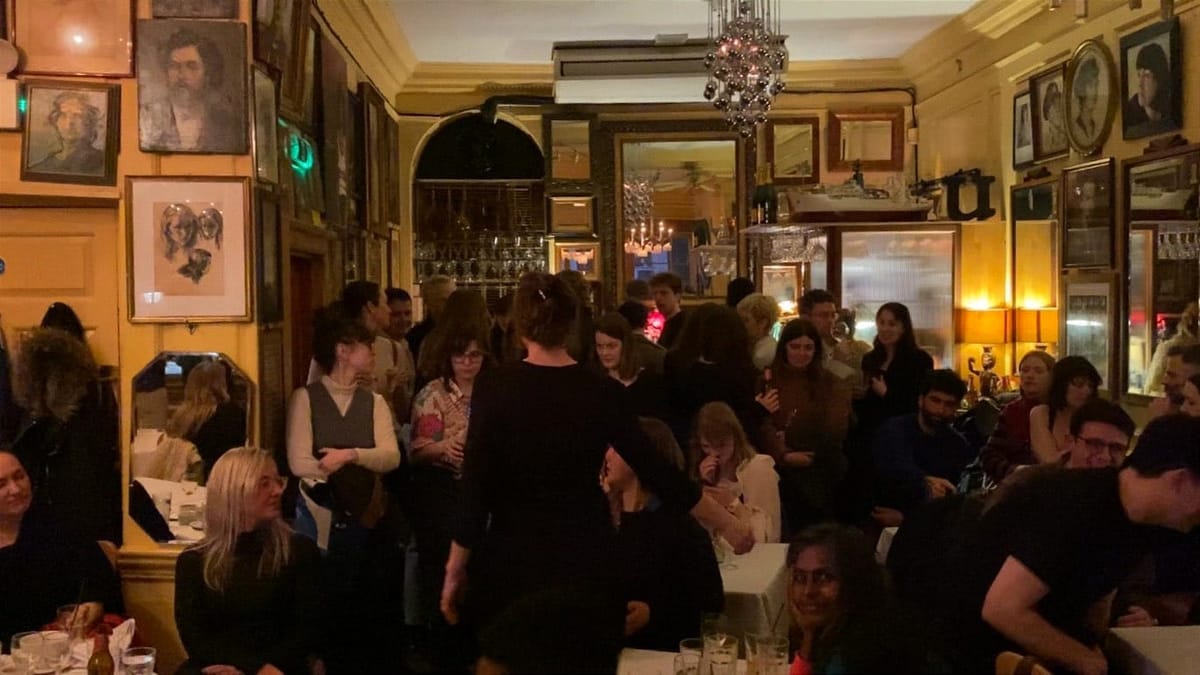
“I spend a lot of time in Dalston but — speaking personally — it can sometimes be frustrating that you have all these businesses, and so many people enjoying the culture and the cuisine, but when it comes to your rights you’re not actually listened to,” he says. “An increase in cultural visibility does come with some benefits, but we still have to advocate for what we need.” He suggests one of the reasons this Dalston hotspot has emerged is the knock-on effect of displacement from areas like Seven Sisters and Elephant and Castle. The theory is an interesting one, although what the area offers seems to be quite different (there are no shops, markets or community centres, for example, and the crowd leans younger), and no one I spoke with thought of it as a replacement.
For now, those involved in the burgeoning scene are just enjoying it for what it is. Bodera is moved by the sense of openness and curiosity that characterises the Latin strip. “The crowd is always a real mix: there’s Latinos, there’s English, there’s Caribbean," he notes. “Last Saturday there was a collaboration of all the Latinos teaching everyone who wasn’t Latino how to dance to the music — people were having the time of their lives. Everyone is included; no-one is left out.”

Comments
How to comment:
If you are already a member,
click here to sign in
and leave a comment.
If you aren't a member,
sign up here
to be able to leave a comment.
To add your photo, click here to create a profile on Gravatar.



